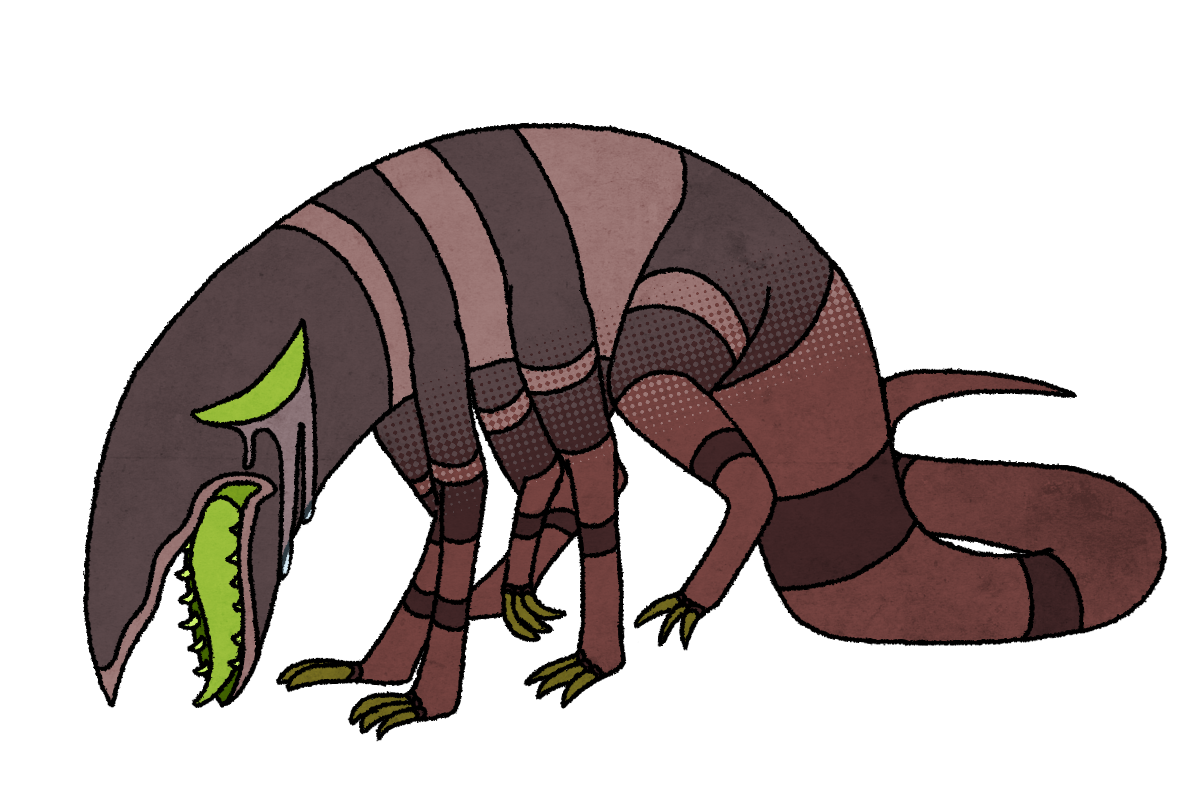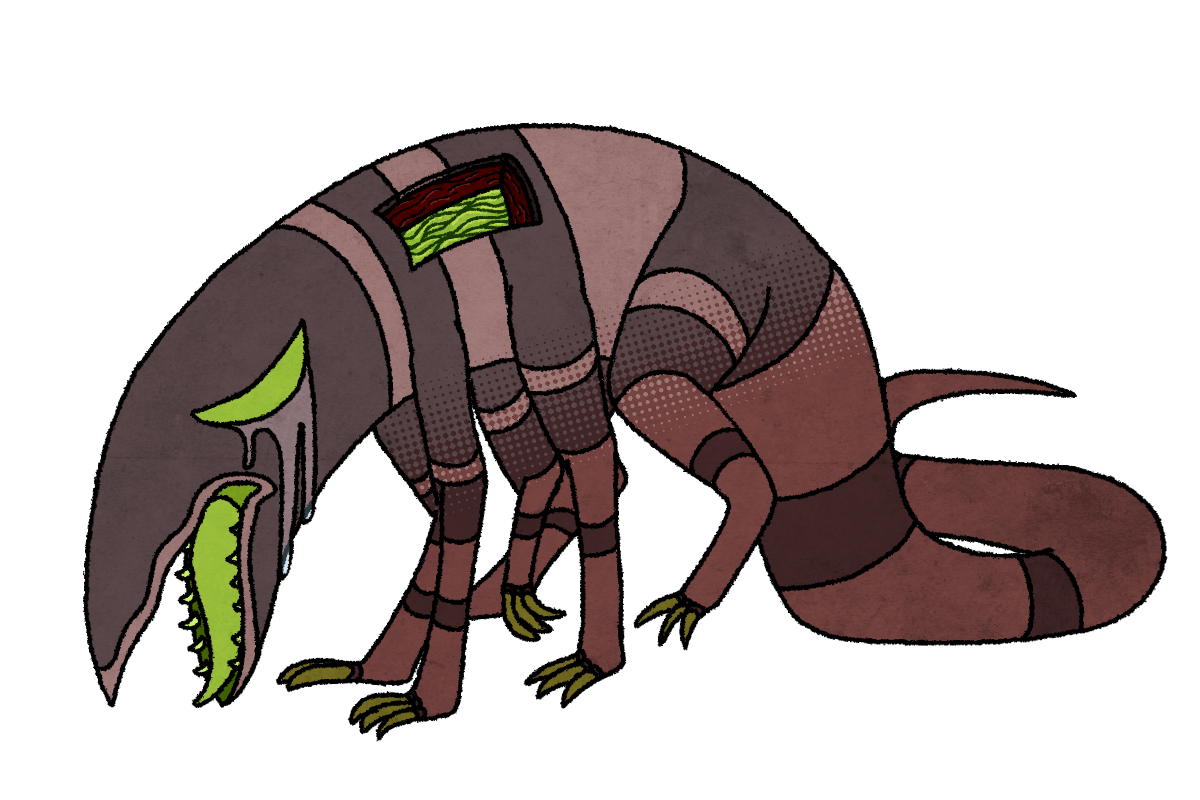


The algosiri is a diminutive stranger with two to three pairs of limbs, downturned blank eye markings, and dull red stripes contrasted by the sickly green color of its eyes, teeth and short tongue. Its skin is pleasantly soft, but sweaty and feverish to the touch. Its flesh is red and sinewy, while its small, vestigial body cavity contains thin, wormlike green organs. Its top jaw is toothless, with only its bottom jaw having rows of evenly spaced teeth, just blunt enough to have difficulty piercing human skin, and its eye markings perpetually weep humanlike tears that tend to seep into its environment over time. Its odor is briny and unpleasant1.
Algosiri handle changes in environment quite poorly, with heat causing its soft skin to become squishy and malleable, and cold freezing it over time. Injuries to the algosiri open and weep gruesomely in a sudden explosion of simultaneous injury, similar to the process an injured sorridronel undergoes, but much faster and stopping after about a second. After this point, its very slow, but present, regenerative ability kicks in, stitching over its violent injuries with rough, pale scar tissue.
The algosiri speaks through choked, hissing sobs that only incidentally resemble a human voice.
1. Plants are growing fairly well today. I caught a whiff of what smelled like saltwater on the way back into the house. Hope there isn't something wrong with my tap. I'll probably need to keep an eye on the soil, just to be safe.

The algosiri generates in a wide range of locations, but tends to prefer places with low lighting and relatively little human activity. It is further attracted by lack of noise and damp conditions. Basements, storage rooms, and abandoned houses are all likely locales for an algosiri infestation, while alleyways and empty hotel rooms are less likely to host them, but still possible. In these locations, the algosiri appears in a limbless, wormlike form, which bloats to full size in a series of restrained movements, as though it is being pushed, but not toppled, by unseen hands. This process takes about an hour, and ends with the algosiri's legs stretching from its body and lifting it onto its feet.
For the first minute-or-so of its life, the algosiri is unbothered and almost serene in its peacefulness and wandering of its surroundings. This period of relaxation ends after 78 seconds, at which point the algosiri suddenly gasps and collapses, suddenly overtaken by its characteristic agony.
The algosiri spends its life plagued by intense pain, particularly in its stiff, tender limbs. The lightest bump to its knee can cause the stranger to recoil and sob, and every step it takes is wracked with pain. Due to the immense difficulty of movement under these conditions, it prefers not to move at all, and spends a majority of its life lying limply in the place where it last collapsed, its raspy crying often belying its position well before anything else. It expresses a personality only in idle taps of its claws or the occasional nudge of its snout against nearby objects.
Occasionally, however, environmental conditions necessitate movement, and it is at these times that the algosiri stumbles back onto its feet and begins to limp along2. Its thick tail drags behind it as it walks with a sloped back and an unsteady gait. It moves very slowly, and can rarely manage longer than fifteen minutes of movement, at which point its legs give out and it collapses where it stands. Because of the limited nature of its movement, algosiri can be found in a plethora of different locations, even those it cannot normally generate in.
By necessity of its mostly-immobile nature, the algosiri's territory is very small, and almost never overlaps with that of another stranger. When it does, the miserable algosiri is either actively avoided or swiftly killed by the other strain.
2. There are footprints in my garden! No wonder my plants aren't growing like they should be. I checked the soil and the mineral content is a lot higher than it should be. Come to think of it, the footprints didn't look like any animal I recognize. Too big to be raccoons, too narrow to be a dog. I hope it's not one of those things.
My shoulders and knees hurt more than normal today. I hope I didn't hurt myself.
The algosiri is ambivalent towards if not somewhat distressed by sensitives. Its sobbing quiets to whispering levels in the presence of a sensitive, and though it prefers to remain in place for as long as possible, if approached too closely or threatened, it will clamber to its feet and begin to move away.
Proximity to the algosiri causes the sharp pain in the joints and back3, the intensity of this pain fluctuating with the movements of the stranger. A limp and undisturbed algosiri causes very little pain; at most it produces a mild, tension-like ache. A moving algosiri, however, produces severe, stabbing agony in the limbs, the pain comparable to having a knife embedded into each joint. This "pain mirror" effect is stronger in younger algosiri and tapers off as the stranger ages.
3. My hunch was right. It's one of them. It's red and green. Found it laying by my banana peppers. It was crying a river and I bet that's why my garden's soil is so bad right now.
I walked over to shoo it off and it stood up and started hobbling away from me. The moment that thing got up I almost had to scream- my arms and legs hurt like hell all of a sudden. I got it out of the garden, but my poor body is going to need some rest, everything still hurts.
Note to self- talk to Kei tomorrow, see if you can work out some way to repel strangers.
5% of algosiri also produce a feeling of nausea as they move, comparable to motion sickness.
An aging algosiri moves less and less frequently and for shorter and shorter amounts of time, eventually becoming entirely incapable of standing. It is due to this that algosiri die more frequently to other strangers than they do natural causes. If it is allowed to live to the very end of its lifespan, it dies with a final spluttering exhale, any new limpness of its body difficult to observe due to its nature. Its body slowly shrinks and flattens down into a sort of papery skin, which crumbles into reddish powder at the slightest touch or breeze.